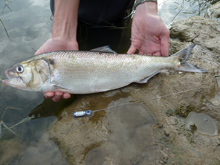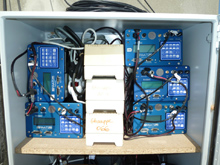The study aims on the identification of the specific requirements of Allis shad towards fish passage facilities. By means of current experiences made in re-introduction programs on the closely related American shad (Alosa sapidissima) in the USA, a fish pass design specifically for the demands of shads will be developed. French experts from the LIFE+ team will visit recently built and modernized facilities in the US and exchange experiences and knowledge with experts from the local programs.
The big shad re-introduction and conservation programs in the USA have a more than 30 year advantage with regard to experiences with the breeding and stocking of shads, however even to measures of habitat improvement and fish passage facilities which meet the specific requirements of shads. In some of these projects the number of returning shads was notably enhanced after modernizing the passage facilities. The gathered knowledge on these technical improvements will be used to define a state-of-the-art fish passage facility design, which takes into account the specific requirements of shads and will, as possible, used to modernize the existing facilities on the Garonne and the Dordogne. In this way, formerly insufficiently accessible but well suited habitats in the middle and upper reaches of the rivers will be made available for spawning shad. The results of the study will be published during the project duration and can be incorporated into future fish passage facilities in along (potential) shad rivers.
The behavior of Allis shad below the transverse structures and the utilization of the existing fish passage facilities during their spawning migration can provide valuable information regarding the availability of suitable spawning habitats in the rivers lower stretches and particularly on the functioning and the efficiency of the passage facilities.
 Foto: EPIDOR
[ Enlarge photo ]
Foto: EPIDOR
[ Enlarge photo ] Photo: EPIDOR
[ Enlarge photo ]
Photo: EPIDOR
[ Enlarge photo ]For this purpose nearly reap shads are caught below the dams of Golfech (Garonne) and Tuilières (Dordogne), narcotized and radio-transmitters inserted into their pharynx. Afterwards the fish are placed in a holding pen and released after they have fully recovered and do not show any impairment from the operation.
By means of transceivers placed below the dams, at the entries and within the fish passage facilities, signals of the individually tagged shads are registered when these pass the respective stations and thus allow drawbacks on their movements and whether they are able to pass the facility. In that way a gathering of additional information as on the influence of attractive currents at the entrance area of the passage facilities and the potential effects of a turbine management are to be expected.
Furthermore, the downstream sections will be monitored by means of mobile receiving units in order to gain information on the patterns of spatio-temporal movements below the dams.
In conjunction with the study on the optimized fish passage facility design the findings shall be incorporated into the optimization of existing and hereafter built passage facilities in the Gironde watersheds.
Like most other anadromous fish, Allis shad perform a complex life-cycle in which different types of habitats are required. The habitat conditions, their availability and accessibility of these habitats are essential for the populations’ healthiness, however impairments, insufficient availabilities or increased mortalities occurring during shifts between these habitats, are amongst the main threats of diadromous fish. In particular with regard to YOY Allis shad habitat requirements and movements between habitats during the freshwater phase and before the emigration to the estuary starts, almost nothing is known. A weekly conducted monitoring of the YOY shall provide information on the abundance of YOY shads in different habitats and thereby allow drawbacks on habitat requirements, however even on the growth and mortality rates in this early phase of life, to assess the potential influences on the insufficient recruitment of shad in the Gironde watersheds. Furthermore additional data like ambient water temperature and water quality parameters will be recorded in order to analyze these effects on the YOY survival. The results of this study will moreover contribute to the optimization of the stocking measures carried out in the Rhine system.
During the previous LIFE Allis shad project the majority of public relation works and press events were restricted to the German part of the project area. In order to sensitize the broad public in France and particularly in the Gironde basin towards the current population trends and threats for the Allis shad in the basin, it is explicitly aspired to increase public relation efforts in France. For this purpose expositions and events will be held and specific information generated on the . By these means the acceptance of the broad public concerning the fishing moratorium, which are still a prerequisite for the conservation of the shad population, shall be increased and the necessity for the conduction of additional conservation measures needs to be clarified, in order to protect the shads, however even the tradition of shad fisheries and the cultural heritage, from a similar decline as once on the Rhine.
Even in Germany and the Netherlands, public relation works aim on keeping alive the importance of Allis shad for local fisheries and the culture of the Rhineland formerly had. The so-called “Maispill”, a traditional folk festival celebrated at the former fishing village Poll near Cologne is a good example how this cultural heritage still lives on. The Maispill, which commemorates the catch of the first Allis shad of a year and the beginning of the merry month May in the former times, provides a good opportunity to present the LIFE+ project at the margins of the festival and to inform the public on the backgrounds, objectives and current developments of the reintroduction project as well as to demonstrate traditional techniques of the former shad fisheries. School classes will be involved and stock Allis shad larvae into the Rhine. In that way they get informed about the particular threats migratory fish are exposed to and what needs to be done to improve the situation for the populations.